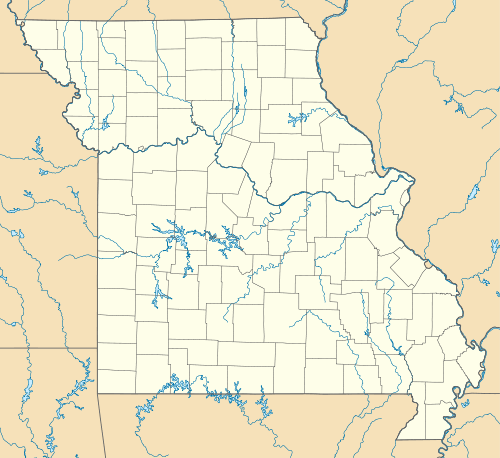Martin City, Missouri
| Martin City | |
|---|---|
| Neighborhood | |
|
2013 St. Patrick's Day Parade in Martin City outside Jess & Jim's | |
 Martin City | |
| Coordinates: 38°51′29″N 94°35′49″W / 38.858038°N 94.596975°WCoordinates: 38°51′29″N 94°35′49″W / 38.858038°N 94.596975°W | |
| Country | United States |
| State | Missouri |
| County | Jackson |
| Area | |
| • Total | 1.965 sq mi (5.09 km2) |
| • Land | 1.965 sq mi (5.09 km2) |
| • Water | 0.0 sq mi (0 km2) |
| Elevation | 892 ft (272 m) |
| Population (2010) | |
| • Total | 686 |
| • Density | 350/sq mi (130/km2) |
| Time zone | Central (CST) (UTC-6) |
| • Summer (DST) | CST (UTC-5) |
| ZIP codes | 64145-1479 |
Martin City is a neighborhood of Kansas City located along the Missouri and Kansas border in southwest Jackson County. The neighborhood was at one time its own, unincorporated town before it was annexed by the City of Kansas City, Missouri in 1963. The Martin City neighborhood is generally defined as being east of the Kansas state line, south of Blue Ridge Boulevard in areas west and north of the Blue River.[1]
History
Martin City was originally platted as Tilden in 1887 by E.L. Martin and John H. Lipscomb. It was named for Samuel Jones Tilden, a presidential candidate who was defeated by Rutherford B. Hayes in 1876.[2] The name was changed in 1895, because there was another town of Tilden in Dallas County. The name "Martin City" came from Edward L. Martin who came to Missouri in 1868 at the age of 26. Martin was famous for organizing the Kansas City Distilling Company, and E. L. Martin & Co. wholesale liquor, as well as serving as the mayor of Kansas City in 1873. During Prohibition, there was drugstore in Martin City where customers could purchase moonshine through a window in the back of the store. The dry goods store had a dance hall upstairs where children and adults could roller-skate. This was the only building of its kind for over 100 miles between Kansas City and Little Rock, Arkansas. This drew travelers from all over Missouri, resulting in a boom in the town's infrastructure. Although business slowed down after prohibition, a prominent stop on the Kansas City Southern Railroad near a local sawmill kept the economy running.
Demographics
As of the census of 2010, there were 686 people, 301 households, and 374 families residing in the neighborhood. The population density was 349 people per square mile (887.5/km²). There were 574 housing units. The racial makeup of the neighborhood was 52.2% White, 32.2% African American, 20.0% Native American, 0.30% Asian, 0.00% Pacific Islander, 0.00% from other races, and 0.56% from two or more races. Hispanic or Latino of any race were 0.10% of the population. The average household size was 2.2 and the average family size was 3.6.
The median income for a household in the neighborhood was $45,551, and the median income for a family was $43,105. Males had a median income of $26,250 versus $21,979 for females. The per capita income for the neighborhood was $14,778. About 40.5% of families and 53.7% of the population were below the poverty line, including 37.5% of those under age 18 and 13.6% of those age 65 or over.
Attractions
Jess & Jim's, a steakhouse and barbecue establishment, has been operating in Martin City since 1938. The building is famous for a large, black cow, that sits on top, greeting customers.
References
- ↑ 1. http://www.city-data.com/neighborhood/Martin-City-Kansas-City-MO.html
- ↑ "Jackson County Place Names, 1928–1945 (archived)". The State Historical Society of Missouri. Retrieved 16 October 2016.
- http://www.city-data.com/zips/64145.html
- http://martincity.org
- http://www.martincity.org/history-of-martin-city/
